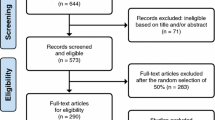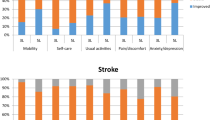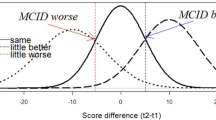Abstract
Purpose
Response shift (RS) is an important phenomenon that influences the assessment of longitudinal changes in health-related quality of life (HRQOL) studies. Given that RS effects are often small, missing data due to attrition or item non-response can contribute to failure to detect RS effects. Since missing data are often encountered in longitudinal HRQOL data, effective strategies to deal with missing data are important to consider. This study aims to compare different imputation methods on the detection of reprioritization RS in the HRQOL of caregivers of stroke survivors.
Methods
Data were from a Canadian multi-center longitudinal study of caregivers of stroke survivors over a one-year period. The Stroke Impact Scale physical function score at baseline, with a cutoff of 75, was used to measure patient stroke severity for the reprioritization RS analysis. Mean imputation, likelihood-based expectation–maximization imputation, and multiple imputation methods were compared in test procedures based on changes in relative importance weights to detect RS in SF-36 domains over a 6-month period. Monte Carlo simulation methods were used to compare the statistical powers of relative importance test procedures for detecting RS in incomplete longitudinal data under different missing data mechanisms and imputation methods.
Results
Of the 409 caregivers, 15.9 and 31.3 % of them had missing data at baseline and 6 months, respectively. There were no statistically significant changes in relative importance weights on any of the domains when complete-case analysis was adopted. But statistical significant changes were detected on physical functioning and/or vitality domains when mean imputation or EM imputation was adopted. There were also statistically significant changes in relative importance weights for physical functioning, mental health, and vitality domains when multiple imputation method was adopted. Our simulations revealed that relative importance test procedures were least powerful under complete-case analysis method and most powerful when a mean imputation or multiple imputation method was adopted for missing data, regardless of the missing data mechanism and proportion of missing data.
Conclusions
Test procedures based on relative importance measures are sensitive to the type and amount of missing data and imputation method. Relative importance test procedures based on mean imputation and multiple imputation are recommended for detecting RS in incomplete data.


Similar content being viewed by others
References
Allison, P. D. (2002). Missing data. Thousand Oaks, CA: Sage.
Allison, P. D. (2003). Missing data techniques for structural equation modelling. Journal of Abnormal Psychology, 112, 545–557.
Boucekine, M., Loundou, A., Baumstarck, K., Minaya-Flores, P., Pelletier, J., Ghattas, B., et al. (2013). Using the random forest method to detect a response shift in the quality of life of multiple sclerosis patients: A cohort study. BMC Medical Research Methodology, 13, 20.
Carpenter, J., & Bithell, J. (2000). Bootstrap confidence intervals: When, which, what? A practical guide for medical statisticians. Statistics in Medicine, 19(9), 1141–1164.
Chernick, M. R. (2008). Bootstrap methods: A guide for practitioners and researchers. New Jersey: Wiley.
Dempster, A. P., Laird, N. M., & Rubin, B. D. (1977). Maximum likelihood from incomplete data via EM algorithm. Journal of the Royal Statistical Society: Series B, 39, 1–38.
Duncan, P. W., Lai, R. K., Bode, R. K., et al. (2003). Stroke Impact Scale-16: A brief assessment of physical function. Neurology, 60, 291–296.
Duncan, P., Wallace, D., Lai, S., Johnson, D., Embretson, S., & Laster, L. (1999). The stroke impact scale version 2.0. Stroke, 30, 2131–2140.
Enders, C. K. (2010). Applied missing data analysis. New York: Guilford Press.
Enders, C. K., & Bandalos, D. L. (2001). The relative performance of full information maximum likelihood estimation for missing data in structural equation models. Structural Equation Modelling, 8, 430–457.
Feeny, D. H., Torrance, G. W., & Furlong, W. J. (1996). Health utilities index. In Bert Spilker (Ed.), Quality of life and pharmacoeconomics in clinical trials, 2 (Vol. 26, pp. 239–252). Philadelphia: Lippincott-Raven Press.
Fielding, S., Fayers, P. M., & Ramsay, C. R. (2009). Investigating the missing data mechanism in quality of life outcomes: A comparison of approaches. Health and Quality of Life Outcomes, 7, 57–66.
Gottschall, A. C., West, S. G., & Enders, C. K. (2012). A comparison of item-level and scale-level multiple imputation for questionnaire batteries. Multivariate Behavioral Research, 47, 1–25.
Graham, J. W., Olchowski, A. E., & Gilreath, T. D. (2007). How many imputations are really needed? Some practical clarifications of multiple imputations theory. Prevention Science, 8, 206–213.
Graham, J. W., Cumsille, P. E., & Elek-Fisk, E. (2003). Methods for handling missing data. In J. A. Schinka & W. F. Velicer (eds.) Research methods in psychology (Vol. 2 pp 87–114) of Handbook of psychology (I. B. Weiner, Editor-in-Chief). New York: Wiley.
Horton, N. J., & Kleinman, K. P. (2007). Much ado about nothing: A comparison of missing data methods and software to fit incomplete regression models. The American Statistician, 61, 79–90.
Ibrahim, J. G., & Molenbergh, G. (2009). Missing data methods in longitudinal studies: A review. Test, 18, 1–43.
Laird, N. M. (1988). Missing data in longitudinal studies. Statistics in Medicine, 7, 305–315.
Li, Y., & Rapkin, B. (2009). Classification and regression tree uncovered hierarchy of psychosocial determinants underlying quality of life response shift in HIV/AIDS. Journal of Clinical Epidemiology, 62, 1138–1147.
Li, Y., & Schwartz, C. E. (2011). Data mining for response shift patterns in multiple sclerosis patients using recursive partitioning tree analysis. Quality of Life Research, 13, 1543–1553.
Lin, T. H. (2006). Missing data imputation in quality of life assessment: Imputation for WHOQOL-BREF. Pharmacoeconomics, 24, 917–925.
Little, R. J. A., & Rubin, B. D. (2002). Statistical analysis with missing data (2nd ed.). New Jersey: Wiley.
Lix, L. M., Sajobi, T. T., Sawatzky, R., Liu, J., Mayo, N. E., Huang, Y., et al. (2013). Relative importance measures for reprioritization response shift. Quality of Life Research, 22, 695–703.
Ma, J., Akhtar-Danesh, N., Dolovich, L., & Thabane, L. (2011). Imputation strategies for missing binary outcomes in cluster randomized trials. BMC Medical Research Methodology, 11, 18.
Mathias, S., Bates, M., Pasta, D., Cisternas, M., Feeny, D., & Patrick, D. (1997). Use of the health utilities index with stroke patients and their caregivers. Stroke, 28, 1888–1894.
Mayo, N. E., Fellows, L. K., Scott, S. C., Cameron, J., & Wood-Dauphinee, S. (2009). A Longitudinal view of apathy and its impact after stroke. Stroke, 40, 3299–3307.
Mayo, N. E., Scott, S. C., Bayley, M., Cheung, A., Garland, J., Jutai, J., & Wood-Dauphinee, S. (2013). Modeling health-related quality of life in people recovering from stroke. Quality of Life Research. doi:10.1007/s11136-013-0605-4.
Mayo, N. E., Scott, S. C., Dendukuri, N., Ahmed, S., & Wood-Dauphinee, S. (2008). Identifying response shift statistically at the individual level. Quality of Life Research, 17, 627–639.
Myers, W. R. (2000). Handling missing data in clinical trials: An overview. Drug Information Journal, 34, 525–533.
Oort, F. J. (2005). Using structural equation modeling to detect response shifts and true change. Quality of Life Research, 14, 587–598.
Oort, F. J., Visser, M. R., & Sprangers, M. A. (2005). An application of structural equation modeling to detect response shifts and true change in quality of life data from cancer patients 10 undergoing invasive surgery. Quality of Life Research, 14, 599–609.
Peugh, J. L., & Enders, C. K. (2004). Missing data in educational research: A review of reporting practices and suggestions for improvement. Review of Educational Research, 74, 525–556.
R Development Core Team (2012). R: A language and environment for statistical computing, reference index version 3.1.0. R Foundation for Statistical Computing, Vienna, Austria.
Rubin, D. B. (1987). Multiple imputation for nonresponse in surveys. New York: Wiley.
Sajobi, T. T., Lix, L. M., Clara, I., Walker, J., Graff, L. L., Rawsthorne, P., et al. (2012). Measures of relative importance for health-related quality of life. Quality of Life Research, 21, 1–11.
SAS Institute Inc. (2012). SAS/STAT user’s guide, version 9.2. Cary, NC: SAS Institute Inc.
Schaffer, J. L. (1997). Analysis of incomplete multivariate data. London: Chapman and Hall.
Schaeffer, J. L., & Graham, J. W. (2002). Missing data: Our view of the state of the art. Psychological Methods, 7, 147–177.
Schaeffer, J. L., & Olsen, M. K. (1998). Multiple imputation for multivariate missing-data problems: A data analyst’s perspective. Multivariate Behavioral Research, 33, 545–571.
Schwartz, C. E., & Sprangers, M. A. G. (1999). Methodological approaches for assessing response shift in longitudinal health-related quality-of-life research. Social Science and Medicine, 48, 1531–1548.
Schwartz, C. E., Sprangers, M. A. G., Carey, A., & Reed, G. (2004). Exploring response shift in longitudinal data. Psychology and Health, 19, 51–69.
Schwartz, C. E., Sajobi, T. T., Lix, L. M., Quaranto, B. R., & Finkelstein, J. A. (2013). Changing values, changing outcomes: The influence of reprioritization response shift on outcome assessment after spine surgery. Quality of Life Research, 22, 2255–2264.
Shrive, F. M., Stuart, H., Quan, H., & Ghali, W. A. (2006). Dealing with missing data in a multi-question depression scale: A comparison of imputation methods. BMC Medical Research Methodology, 6, 57.
Thomas, D. R. (1992). Interpreting discriminant functions: A data analytic approach. Multivariate Behavioural Research, 27, 218–223.
Thomas, D. R., & Zumbo, B. D. (1996). Using a measure of variable importance to investigate the standardization of discriminant coefficients. Journal of Educational and Behavioral Statistics, 21, 110–130.
Ware, J. E., & Sherbourne, C. D. (1992). The MOS 36-item short-form health survey (SF-36). I. Conceptual framework and item selection. Medical Care, 30, 473–483.
Acknowledgments
This research was supported by a University of Calgary seed Grant to the first author, and a Canadian Institutes of Health Research (CIHR) operating grant to the first, second, and last author (Funding Reference Number TOO-105432). The authors also acknowledge David Schluz’s technical support for the simulation undertaking and the helpful discussions of Drs. Diane Fairclough and Carolyn Schwartz.
Author information
Authors and Affiliations
Corresponding author
Appendices
Appendix 1
Relative importance tests for response shift detection in incomplete longitudinal data.
To implement relative importance tests under complete-case analysis method, observations with at least one missing observation on any of the domains are deleted. The differences in relative weights are conducted on the complete data. Similarly, for the mean imputation and EM imputation methods, tests of differences in relative importance weights are conducted on the mean imputed and EM imputed datasets, respectively.
In contrast, for multiple imputation methods, the following steps are taking to implement the relative importance tests.
-
1.
Estimate the observed differences in relative importance weights for domains on the original data. This is accomplished as follows:
-
a.
Multiply impute the original incomplete longitudinal data by creating M copies of the imputed dataset.
-
b.
For each imputed dataset, estimate the relative importance weights at each occasions (w 1mk and w 2mk ; m = 1, …, M; k = 1, …, p) and the differences in relative importance weights over the two occasions (i.e., W mk = w 1mk –w 2mk ).
-
c.
Use Rubin’s rule as described in Sect. “Methods” to combine the estimates of the differences in relative importance weights for the M datasets. The average difference in relative importance weights is called the observed relative importance weights, \( \hat{W}_{k} \).
-
a.
-
2.
Generate the distribution of the differences in relative importance weights by repeatedly sampling from the original incomplete data with replacement (say B times).
-
a.
For each bootstrapped incomplete dataset, implement steps 1a–c to estimate the bootstrap-specific differences in relative weights \( \hat{W}_{bk} \).
-
b.
Sort the \( \hat{W}_{bk} \) s (b = 1, 2, …, B) from the smallest to the highest. This is the bootstrap distribution of the difference in relative importance weights from the B bootstrap samples.
-
c.
Estimate the W bk s that corresponds to the 100 (α/2)th percentile (W bkL ) and the 100 (1−α/2)th percentile (W bkU ) of the bootstrap distribution.
-
a.
-
3.
Statistical significance of the differences in relative importance weights on a domain is considered present if W k is outside the interval (W bkL , W bkU ).
Appendix 2
Description of missing data patterns in the longitudinal study of stroke caregivers.
See Table 5.
Appendix 3
Rights and permissions
About this article
Cite this article
Sajobi, T.T., Lix, L.M., Singh, G. et al. Identifying reprioritization response shift in a stroke caregiver population: a comparison of missing data methods. Qual Life Res 24, 529–540 (2015). https://doi.org/10.1007/s11136-014-0824-3
Accepted:
Published:
Issue Date:
DOI: https://doi.org/10.1007/s11136-014-0824-3




